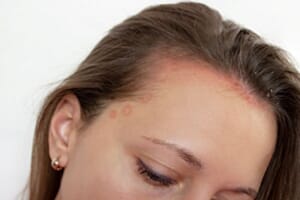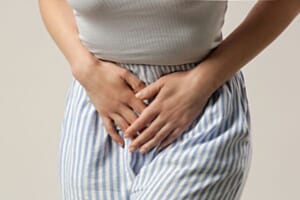Red Skin Syndrome (RSS) is an emerging problem for people who have spent years using steroid creams to control their eczema, acne or rosacea.
Red Skin Syndrome is effectively an ‘allergic reaction’ to the withdrawal of the regular use of topical steroid skin creams. It’s also knows as Topical Steroid Withdrawal.
Very few people with eczema, acne or rosacea have not used steroid creams to control their symptoms at some stage, either on prescription from their doctor or dermatologist or bought over the counter at a pharmacy.
While some people try and seek alternatives to steroids, the majority of people follow standard advice and treatments from doctors and dermatologists who still predominantly encourage people with eczema, acne and rosacea to use steroid creams, lotions and gels to control their symptoms.
But now eczema, acne and rosacea sufferers are paying the price for this seemingly simple solution for managing their symptoms.
Red Skin Syndrome in a growing secondary health condition caused by the overuse of steroids creams for controlling dry skin or acne based skin conditions.
Many eczema and acne sufferers have been using steroid creams from their childhood or teens and eventually become resistant to them or decide to stop using them due to other side effects such as skin discolouration or skin ‘thinning’.
The principle reason many acne and eczema sufferers decide to stop using steroid treatments is when their symptoms seem to get worse and spread to other areas. They feel their skin is getting worse and not better. In fact the skin condition is not getting any worse, what has happened is that their skin has become resistant to the steroids and so they are less effective at controlling symptoms.
According to itsan.org, a red skin syndrome support organisation, the problem of Red Skin Syndrome usually arises when steroid creams that have been used for a long period of time, often several years, are either drastically reduced or suddenly stopped altogether and the skin goes into a state of ‘shock’.
What are the symptoms of Red Skin Syndrome?
Red Skin Syndrome symptoms include sudden red, hot and itchy skin, skin swelling, skin tightening, skin with a painful burning sensation and very dry and flaking skin.
Skin effected by Red Skin Syndrome can also become highly sensitive and it can trigger multiple other allergic reactions to skincare products, shampoos and cosmetics. Sufferers can start to feel that everything they put on their skin burns or stings. Even applying water can be painful in more severe cases.
Red Skin Syndrome can occur in a longer than normal gap between steroid treatments or, more commonly, when steroid use is stopped altogether.
How can you reduce the risk of Red Skin Syndrome?
- If you have been using steroids for a long period of time and wish to stop, make sure you reduce your dosage gradually and progressively. Don’t just suddenly stop.
- Seek out other non-steroid alternatives to help control symptoms that can be used in between flare ups and break out to try and manage and lessen symptoms.
For eczema try Cardiospermum Gel or Defensil Rescue Serum which are both non-steroid treatments that can help reduce itching, dryness and redness and can be used daily in between symptoms.
For rosacea try K ALME products that can help reduce redness, inflammation and sensitivity while also putting moisture back into dry red skin. They contain no chemicals and are formulated for hyper sensitive skin.
For acne try Silver Serum, a natural treatment which helps control acne by replenishing the levels of good skin flora wiped out or weakened by long-term use of antibacterial agents. High levels of good skin flora helps the skin naturally fight the acne bacteria and builds a stronger resistance to it. Anti-acne medications and anti-bacterial agents kill of all skin bacteria, including the good stuff, and when used for long period of time leave skin weak, dry and even more vulnerable to being overrun with acne bacteria once medications cease or the skin becomes resistant to them .
Use these alternatives daily between flare ups and break outs. Its crucial to make a note of how long the period of time is between flare ups to see if it's increasing with the regular use of the alternatives.
It will take a bit of time for the skin to adjust to more natural and gentler forms of skin management, so be patient. The main thing is to note if there is any improvement at all in symptoms, no matter how small to begin with and whether the time between flare ups or outbreaks is increasing.
- Focus on keeping skin well-conditioned in between flare ups. Use non irritating moisturisers or skin oils twice daily, wash skin regularly, wear natural fibre clothes next to your skin. Exfoliate the skin gently 2-3 times a week.
For eczema prone skin bath twice a week in oat bath treatments such as Oat Soak to help soften skin and reduce itching and flaking.
- Turn down the central heating and use a humidifier. Try to create a home environment that is less drying for your skin during the period when you are trying to reduce your steroid treatments.
- Take a daily fish oil supplement for 2-3 months to try and help increase the natural oils in your skin to combat the excessive dryness that is likely to occur when reducing steroid use.
- Increase good skin flora in your skin. Good skin flora can help repair the skin barrier and help keep out bad bacteria from infecting dry eczema cracks or open acne or rosacea lesions or bumps on the skin.
Try Silver Serum which is a natural daily skin serum that promotes the growth of good skin flora while inhibiting the growth of bad skin bacteria. Use twice daily after washing or cleansing on all vulnerable areas of skin prone to flare ups or break outs.








Thank you in advance.